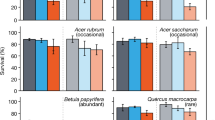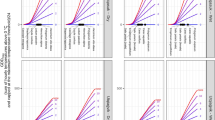Abstract
Populations near the warm edge of species ranges may be particularly sensitive to climate change1,2,3,4, but lack of empirical data on responses to warming represents a key gap in understanding future range dynamics. Herein we document the impacts of experimental warming on the performance of 11 boreal and temperate forest species that co-occur at the ecotone between these biomes in North America5. We measured in situ net photosynthetic carbon gain and growth of >4,100 juvenile trees from local seed sources exposed to a chamberless warming experiment that used infrared heat lamps and soil heating cables to elevate temperatures by +3.4 °C above- and belowground6 for three growing seasons across 48 plots at two sites. In these ecologically realistic field settings, species growing nearest their warm range limit exhibited reductions in net photosynthesis and growth, whereas species near their cold range limit responded positively to warming. Differences among species in their three-year growth responses to warming parallel their photosynthetic responses to warming, suggesting that leaf-level responses may scale to whole-plant performance. These responses are consistent with the hypothesis, from observational data and models4,7,8,9,10, that warming will reduce the competitive ability of currently dominant southern boreal species compared with locally rarer co-occurring species that dominate warmer neighbouring regions.
This is a preview of subscription content, access via your institution
Access options
Subscribe to this journal
Receive 12 print issues and online access
$209.00 per year
only $17.42 per issue
Buy this article
- Purchase on Springer Link
- Instant access to full article PDF
Prices may be subject to local taxes which are calculated during checkout



Similar content being viewed by others
References
Walther, G-R. Community and ecosystem responses to recent climate change. Proc. R. Soc. Lond. B 365, 2019–2024 (2010).
Pucko, C., Beckage, B., Perkins, T. & Keeton, W. S. Species shifts in response to climate change: Individual or shared responses? J. Torrey Bot. Soc. 138, 156–176 (2011).
Davis, M. B. & Shaw, R. G. Range shifts and adaptive responses to Quaternary climate change. Science 292, 673–679 (2001).
Reich, P. B. & Oleksyn, J. Climate warming will reduce growth and survival of Scots pine except in the far north. Ecol. Lett. 11, 588–597 (2008).
Friedman, S. K. & Reich, P. B. Regional legacies of logging: Departure from presettlement forest conditions in northern Minnesota. Ecol. Appl. 15, 726–744 (2005).
Rich, R. L. et al. Design and performance of combined infrared canopy and belowground warming in the B4WarmED (Boreal Forest Warming at an Ecotone in Danger) experiment. Glob. Change Biol. (in the press).
Peng, C. et al. A drought-induced pervasive increase in tree mortality across Canada’s boreal forests. Nature Clim. Change 1, 467–471 (2011).
Ma, Z. et al. Regional drought-induced reduction in the biomass carbon sink of Canada’s boreal forests. Proc. Natl Acad. Sci. USA 109, 2423–2427 (2012).
Fisichelli, N., Frelich, L. E. & Reich, P. B. Sapling growth responses to warmer temperatures ‘cooled’ by browse pressure. Glob. Change Biol. 18, 3455–3463 (2012).
Iverson, L. R. & Prasad, A. M. Predicting abundance of 80 tree species following climate change in the eastern United States. Ecol. Monogr. 68, 465–485 (1998).
Sakai, A. & Weiser, C. J. Freezing resistance of trees in North America with reference to tree regions. Ecology 54, 118–126 (1973).
Strimbeck, G. R., Kjellsen, T. D., Schaberg, P. G. & Murakami, P. F. Dynamics of low-temperature acclimation in temperate and boreal conifer foliage in a mild winter climate. Tree Physiol. 28, 1365–1374 (2008).
Loehle, C. Height growth rate tradeoffs determine northern and southern range limits for trees. J. Biogeogr. 25, 735–742 (1998).
Koehler, G. et al. Proteomic study of low-temperature responses in strawberry cultivars that differ in cold tolerance. Plant Physiol. 159, 1787–1805 (2012).
Savage, J. A. & Cavender-Bares, J. Phenological cues drive an apparent trade-off between freezing tolerance and growth in the family Salicaceae. Ecology 94, 1708–1717 (2013).
Rehfeldt, G. E., Ying, C. C., Spittlehouse, D. L. & Hamilton, D. A. Jr Genetic responses to climate in Pinus contorta: Niche breadth, climate change, and reforestation. Ecol. Monogr. 69, 375–407 (1999).
Hughes, A. R., Inouye, B. D., Johnson, M. T. J., Underwood, N. & Vellend, M. Ecological consequences of genetic diversity. Ecol. Lett. 11, 609–623 (2008).
Barbour, R. C. et al. A geographic mosaic of genetic variation within a foundation tree species and its community-level consequences. Ecology 90, 1762–1772 (2009).
Cahill, A. E. et al. How does climate change cause extinction? Proc. R. Soc. Lond. B 280, 20121890 (2013).
Messaoud, Y., Bergeron, Y. & Asselin, H. Reproductive potential of balsam fir (Abies balsamea), white spruce (Picea glauca), and black spruce (P. mariana) at the ecotone between mixedwood and coniferous forests in the boreal zone of western Quebec. Am. J. Bot. 94, 746–754 (2007).
Burns, R. M. & Honkala, B. H. Silvics of North America Vol. 1 (Agriculture Handbook 654, US Department of Agriculture, Forest Service, 1990).
Burns, R. M. & Honkala, B. H. Silvics of North America Vol. 2 (Agriculture Handbook 654, US Department of Agriculture, Forest Service, 1990).
Guisan, A. & Thuiller, W. Predicting species distribution: Offering more than simple habitat models. Ecol. Lett. 8, 993–1009 (2005).
Bakkenes, M., Alkemade, J. R. M., Ihle, F., Leemans, R. & Latour, J. B. Assessing effects of forecasted climate change on the diversity and distribution of European higher plants for 2050. Glob. Change Biol. 8, 390–407 (2002).
Midgley, G. F., Hannah, L., Millar, D., Thuiller, W. & Booth, A. Developing regional and species-level assessments of climate change impacts on biodiversity in the Cape Floristic Region. Biol. Conserv. 112, 87–97 (2003).
Thuiller, W., Lavorel, S., Midgley, G. F., Lavergne, S. & Rebelo, A. G. Relating plant traits and species distributions along bioclimatic gradients for 88 Leucadendron species in the Cape Floristic Region. Ecology 85, 1688–1699 (2004).
Heinselman, M. Fire in the virgin forests of the Boundary Waters Canoe Area, Minnesota. Quat. Res. 3, 329–382 (1973).
Grigal, D. F. & Ohmann, L. F. Classification, description, and dynamics of upland plant communities within a Minnesota wilderness area. Ecol. Monogr. 45, 389–407 (1975).
Sendall, K. M. et al. Acclimation of photosynthetic temperature optima of temperate and boreal tree species in response to experimental forest warming. Glob. Change Biol.http://dx.doi.org/10.1111/gcb.12781 (2014).
Price, D. T. et al. Anticipating the consequences of climate change for Canada’s boreal forest ecosystems. Environ. Rev. 21, 322–365 (2013).
Bradshaw, R. H. W. & Zackrisson, O. A two thousand year record of a northern Swedish boreal forest stand. J. Vegetation Sci. 1, 519–528 (1990).
Rich, R. L., Frelich, L. E. & Reich, P. B. Windthrow mortality in the southern boreal forest: Effects of species, diameter, and stand age. J. Ecol. 95, 1261–1273 (2007).
Acknowledgements
This research was supported by the Office of Science (BER), US Department of Energy, 385 Grant No. DE-FG02-07ER64456, by the Minnesota Department of Natural Resources, and by the College of Food, Agricultural, and Natural Resources Sciences and Wilderness Research Foundation, University of Minnesota. Assistance with experimental operation and data collection was provided by C. Buschena, C. Zhao, K. Gill, H. Jihua, X. Wei and numerous summer interns. We also thank N. Danz, J. Almendinger and K. Zhu for assistance in identifying the range limits and local ecotonal distributions of species, and A. Pierce for operational support.
Author information
Authors and Affiliations
Contributions
P.B.R., R.A.M., S.E.H. and R.L.R. designed the study. R.L.R. designed the warming system. K.M.S., K.R. and A.S. implemented the warming system and/or day-to-day field measurements. P.B.R. analysed the data. P.B.R. and the other co-authors jointly wrote the manuscript.
Corresponding author
Ethics declarations
Competing interests
The authors declare no competing financial interests.
Supplementary information
Rights and permissions
About this article
Cite this article
Reich, P., Sendall, K., Rice, K. et al. Geographic range predicts photosynthetic and growth response to warming in co-occurring tree species. Nature Clim Change 5, 148–152 (2015). https://doi.org/10.1038/nclimate2497
Received:
Accepted:
Published:
Issue Date:
DOI: https://doi.org/10.1038/nclimate2497
This article is cited by
-
The relevance of plant translocation as a conservation tool in France
Plant Ecology (2023)
-
Oxalate oxidase transgene expression in American chestnut leaves has little effect on photosynthetic or respiratory physiology
New Forests (2023)
-
Even modest climate change may lead to major transitions in boreal forests
Nature (2022)
-
Impacts of climate modes on temperature extremes over Bangladesh using statistical methods
Meteorology and Atmospheric Physics (2022)
-
Phenological responsiveness and fecundity decline near the southern range limit of Trientalis borealis (Primulaceae)
Plant Ecology (2022)



